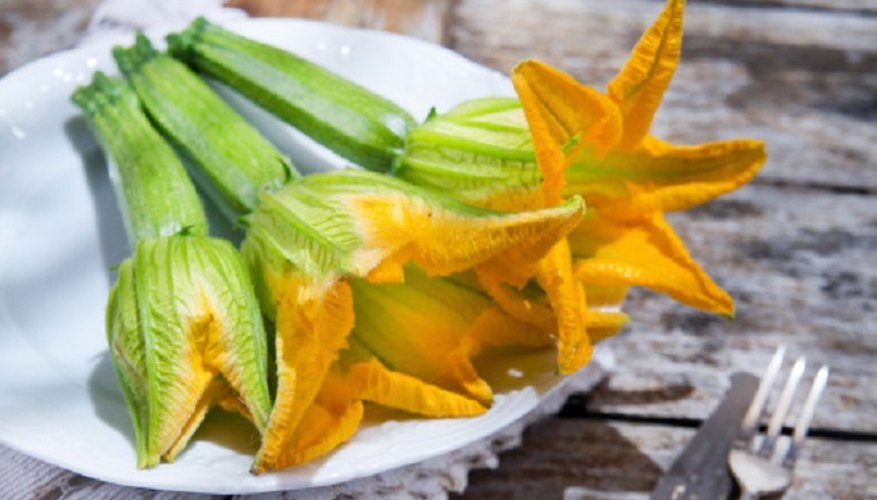A type of annual summer squash (Cucurbita pepo), the courgette plant grows as a warm-season annual vine. It grows quickly, producing both male and female-gendered golden yellow blossoms. Only female flowers, once pollinated, become the green "vegetable" fruits. Gardeners may opt to remove courgette flowers to limit fruit production or to eat the blossoms.
Importance of flowers
Don't be too hasty to pluck off the blossoms on the courgette vine. Without adequate blooms, no fruits develop. You need to closely look at the flower to learn which sex it is; both male and female flowers are needed. Bees visit both flowers and facilitate pollination. Male flowers contain stamens with pollen, while the female blossoms have a sticky pistil and a swollen base that houses the ovaries. Removing the wrong number of either flower type limits fruit production.
- Don't be too hasty to pluck off the blossoms on the courgette vine.
- You need to closely look at the flower to learn which sex it is; both male and female flowers are needed.
Reasons to remove flowers
Once the courgette plant is mature enough to produce flowers, and the weather remains warm, they occur in large numbers. If you feel too many courgette fruits are being produced, you can opt to pluck flowers off to control the number of fruits made. Courgette flowers also are edible. You can remove blossoms to eat fresh in a salad, or more famously, stuffed with various savoury foods like cheese to bake or roast and eat. Wilted female flowers with tiny fruits also taste good fried and breaded.
- Once the courgette plant is mature enough to produce flowers, and the weather remains warm, they occur in large numbers.
- If you feel too many courgette fruits are being produced, you can opt to pluck flowers off to control the number of fruits made.
Managing a courgette vine
According to the University of Illinois, one of the main errors done by gardeners is not harvesting courgette properly. Once pollinated, a female courgette blossom rapidly matures. Harvest courgettes when immature so the skin is soft and flesh tender and flavourful. Pick a courgette when it's between 2.5 and 5 cm (1 and 2 inches) in diameter and about 15 to 20 cm (6 to 8 inches) long, which means scanning over a productive plant every one to two days. Remove larger, mature courgettes since they drain energy from the vine and decrease productivity. Over-ripe courgettes have hard skin and flesh riddled with seeds. Cut them off the vine and discard them to encourage continued flowering.
- According to the University of Illinois, one of the main errors done by gardeners is not harvesting courgette properly.
- Remove larger, mature courgettes since they drain energy from the vine and decrease productivity.
Gardening insight
Rather than planting multiple courgette plants, it may serve the gardener best to plant only one vine. The courgette begins flowering and setting fruits about 45 days after the seeds are sowed. The more the fruits that are picked, the more the vine produces additional flowers. It truly produces a lot of courgette over the summer, sometimes too many for one household.
- Rather than planting multiple courgette plants, it may serve the gardener best to plant only one vine.
